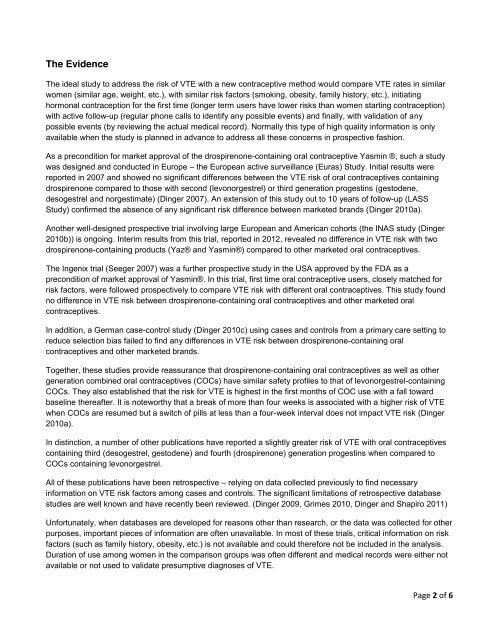POSITION STATEMENT
POSITION STATEMENT
POSITION STATEMENT
You also want an ePaper? Increase the reach of your titles
YUMPU automatically turns print PDFs into web optimized ePapers that Google loves.
The Evidence<br />
The ideal study to address the risk of VTE with a new contraceptive method would compare VTE rates in similar<br />
women (similar age, weight, etc.), with similar risk factors (smoking, obesity, family history, etc.), initiating<br />
hormonal contraception for the first time (longer term users have lower risks than women starting contraception)<br />
with active follow-up (regular phone calls to identify any possible events) and finally, with validation of any<br />
possible events (by reviewing the actual medical record). Normally this type of high quality information is only<br />
available when the study is planned in advance to address all these concerns in prospective fashion.<br />
As a precondition for market approval of the drospirenone-containing oral contraceptive Yasmin ®, such a study<br />
was designed and conducted in Europe – the European active surveillance (Euras) Study. Initial results were<br />
reported in 2007 and showed no significant differences between the VTE risk of oral contraceptives containing<br />
drospirenone compared to those with second (levonorgestrel) or third generation progestins (gestodene,<br />
desogestrel and norgestimate) (Dinger 2007). An extension of this study out to 10 years of follow-up (LASS<br />
Study) confirmed the absence of any significant risk difference between marketed brands (Dinger 2010a).<br />
Another well-designed prospective trial involving large European and American cohorts (the INAS study (Dinger<br />
2010b)) is ongoing. Interim results from this trial, reported in 2012, revealed no difference in VTE risk with two<br />
drospirenone-containing products (Yaz® and Yasmin®) compared to other marketed oral contraceptives.<br />
The Ingenix trial (Seeger 2007) was a further prospective study in the USA approved by the FDA as a<br />
precondition of market approval of Yasmin®. In this trial, first time oral contraceptive users, closely matched for<br />
risk factors, were followed prospectively to compare VTE risk with different oral contraceptives. This study found<br />
no difference in VTE risk between drospirenone-containing oral contraceptives and other marketed oral<br />
contraceptives.<br />
In addition, a German case-control study (Dinger 2010c) using cases and controls from a primary care setting to<br />
reduce selection bias failed to find any differences in VTE risk between drospirenone-containing oral<br />
contraceptives and other marketed brands.<br />
Together, these studies provide reassurance that drospirenone-containing oral contraceptives as well as other<br />
generation combined oral contraceptives (COCs) have similar safety profiles to that of levonorgestrel-containing<br />
COCs. They also established that the risk for VTE is highest in the first months of COC use with a fall toward<br />
baseline thereafter. It is noteworthy that a break of more than four weeks is associated with a higher risk of VTE<br />
when COCs are resumed but a switch of pills at less than a four-week interval does not impact VTE risk (Dinger<br />
2010a).<br />
In distinction, a number of other publications have reported a slightly greater risk of VTE with oral contraceptives<br />
containing third (desogestrel, gestodene) and fourth (drospirenone) generation progestins when compared to<br />
COCs containing levonorgestrel.<br />
All of these publications have been retrospective – relying on data collected previously to find necessary<br />
information on VTE risk factors among cases and controls. The significant limitations of retrospective database<br />
studies are well known and have recently been reviewed. (Dinger 2009, Grimes 2010, Dinger and Shapiro 2011)<br />
Unfortunately, when databases are developed for reasons other than research, or the data was collected for other<br />
purposes, important pieces of information are often unavailable. In most of these trials, critical information on risk<br />
factors (such as family history, obesity, etc.) is not available and could therefore not be included in the analysis.<br />
Duration of use among women in the comparison groups was often different and medical records were either not<br />
available or not used to validate presumptive diagnoses of VTE.<br />
Page 2 of 6


